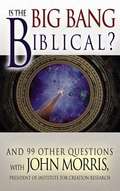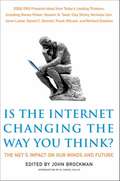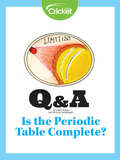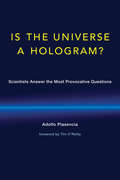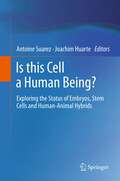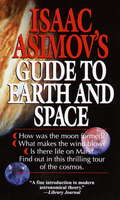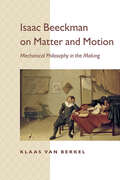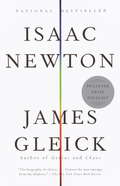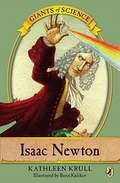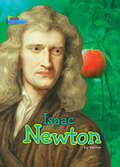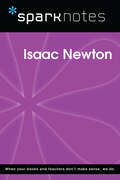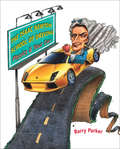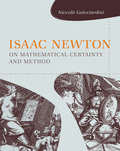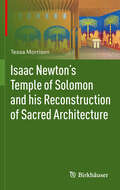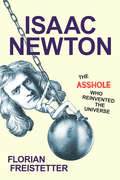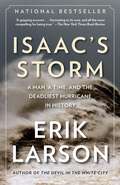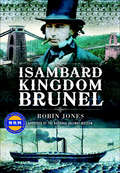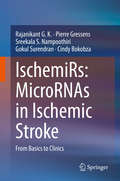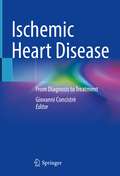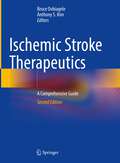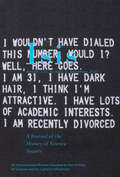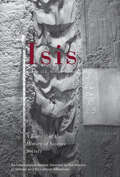- Table View
- List View
Is a Blue Whale the Biggest Thing There Is?
by Robert E WellsThe blue whale is the biggest creature on Earth. But a hollow Mount Everest could hold billions of whales! And though Mount Everest is enormous, it is pretty small compared to the planet Earth. This book is an innovative exploration of size and proportion.
Is the Big Bang Biblical?
by Dr John D. MorrisAlmost everyone has an interest in science. Whether we're simply star-gazing, or conducting laboratory experiments, studying the world around us offers marvelous opportunities to learn. As the natural world unfolds around us, it also prompts philosophical questions: Where did it all come from? Did someone make all this? Geologist and author John Morris, President of the Institute for Creation Research, if often asked a host of questions about how our world came to be. In this book, he answers a hundred of the most common questions, and the variety of topics will excite readers of all ages. In his clear, non-technical style, Morris tackles the following: Has evidence for Noah's flood been found in the Black Sea? Can science prove the Bible? Doesn't carbon dating prove the earth is old? If all animals were created as plant eaters, why do some have sharp teeth? Is there water on the moon? What about stem cell research? And many more!
Is the Internet Changing the Way You Think?
by John BrockmanHow is the internet changing the way you think? That is one of the dominant questions of our time, one which affects almost every aspect of our life and future. And it's exactly what John Brockman, publisher of Edge.org, posed to more than 150 of the world's most influential minds. Brilliant, farsighted, and fascinating, Is the Internet Changing the Way You Think? is an essential guide to the Net-based world.
Is the Periodic Table Complete?
by Lizzie WadeA nuclear chemist explains what is required to discover a new element.
Is the Universe a Hologram?: Scientists Answer the Most Provocative Questions (The\mit Press Ser.)
by Adolfo PlasenciaQuestions about the physical world, the mind, and technology in conversations that reveal a rich seam of interacting ideas.Science today is more a process of collaboration than moments of individual “eurekas.” This book recreates that kind of synergy by offering a series of interconnected dialogues with leading scientists who are asked to reflect on key questions and concepts about the physical world, technology, and the mind. These thinkers offer both specific observations and broader comments about the intellectual traditions that inform these questions; doing so, they reveal a rich seam of interacting ideas.The persistent paradox of our era is that in a world of unprecedented access to information, many of the most important questions remain unsolved. These conversations (conducted by a veteran science writer, Adolfo Plasencia) reflect this, with scientists addressing such issues as intelligence, consciousness, global warming, energy, technology, matter, the possibility of another earth, changing the past, and even the philosophical curveball, “is the universe a hologram?”The dialogues discuss such fascinating aspects of the physical world as the function of the quantum bit, the primordial cosmology of the universe, and the wisdom of hewn stones. They offer optimistic but reasoned views of technology, considering convergence culture, algorithms, “Beauty ≠ Truth,” the hacker ethic, AI, and other topics. And they offer perspectives from a range of disciplines on intelligence, discussing subjects that include the neurophysiology of the brain, affective computing, collaborative innovation, and the wisdom of crowds.Conversations withHal Abelson, Ricardo Baeza-Yates, John Perry Barlow, Javier Benedicto, José Bernabéu, Michail Bletsas, Jose M. Carmena, David Casacuberta, Yung Ho Chang, Ignacio Cirac, Gianluigi Colalucci, Avelino Corma, Bernardo Cuenca Grau, Javier Echeverria, José Hernández-Orallo, Hiroshi Ishii, Pablo Jarillo-Herrero, Henry Jenkins, Anne Margulies, Mario J. Molina, Tim O'Reilly, John Ochsendorf, Paul Osterman, Alvaro Pascual-Leone, Rosalind W. Picard, Howard Rheingold, Alejandro W. Rodriguez, Israel Ruiz, Sara Seager, Richard Stallman, Antonio Torralba, Bebo White, José María Yturralde
Is this Cell a Human Being?
by Antoine Suarez Joachim HuarteThe central question of this book is whether or not particular cell entities of human origin ought to be considered human beings. The answer is crucial for making moral decisions for or against research and experimentation. Experts in the field discuss the production of embryonic-like pluripotent stem cells by altered nuclear transfer, parthenogenesis and reprogramming of adult somatic cells. They thoroughly analyse the biological and moral status of different cell entities, such as human stem cells, embryos and human-animal hybrid embryos, and make a decisive step towards establishing final criteria for what constitutes a human being. The topic is challenging in nature and of broad interest to all those concerned with current bioethical thought on embryonic human life and its implications for society.
Isaac Asimov's Guide to Earth and Space
by Isaac AsimovA wide-ranging exploration of our universe -- from "what makes the wind blow?" to "how was the moon formed?" -- in questions-and-answer format, written in vintage Asimov style. "A fine introduction to modern astronomical theory." -- LIBRARY JOURNALFrom the Paperback edition.
Isaac Beeckman on Matter and Motion: Mechanical Philosophy in the Making
by Klaas van BerkelExplore the work of a founding father of the mechanical philosophy of nature, Isaac Beeckman (1588–1637).The contribution of the Dutch craftsman and scholar Isaac Beeckman to early modern scientific thought has never been properly acknowledged. Surprisingly free from the constraints of traditional natural philosophy, he developed a view of the world in which everything, from the motion of the heavens to musical harmonies, is explained by reducing it to matter in motion. His ideas deeply influenced Descartes and Gassendi. Klaas van Berkel has succeeded in unearthing and explicating Beeckman's scientific notebooks, allowing us to follow how he developed his new philosophy, almost day by day.Beeckman was almost forgotten until the discovery of his notebooks in the early twentieth century. Isaac Beeckman on Matter and Motion is the first full-length study of the ideas and motives of this remarkable figure. Van Berkel's important study first relates Beeckman's life, placing him in the religious, intellectual, educational, and social context of the Dutch Republic in its golden age. Van Berkel then analyzes the notebooks themselves and the nature and development of Beeckman's "mechanical philosophy." He demonstrates how Beeckman's artisanal background and religious convictions shaped his natural philosophy, even as the decisive influence stems from the educational philosophy of the sixteenth-century French philosopher Peter Ramus. Historians of science and the philosophy of science will find the substance of Beeckman's thought and the unraveling of its growth and development highly interesting. Van Berkel's account provides a new and comprehensive interpretation of the origins of the mechanical philosophy of nature, the philosophy that culminated in the work of Isaac Newton.
Isaac Newton
by Andrew Janiak Isaac NewtonSir Isaac Newton (1642-1727) left a voluminous legacy of writings. Despite his influence on the early modern period, his correspondence, manuscripts, and publications in natural philosophy remain scattered throughout many disparate editions. In this volume, Newton's principal philosophical writings are for the first time collected in a single place. They include excerpts from the Principia and the Opticks, his famous correspondence with Boyle and with Bentley, and his equally significant correspondence with Leibniz, which is often ignored in favor of Leibniz's later debate with Samuel Clarke. Newton's exchanges with Leibniz place their different understandings of natural philosophy in sharp relief. The volume also includes 'De Gravitatione', offered here in a corrected translation, which is crucial for understanding Newton's relation to his great predecessor Descartes. In a historical and philosophical introduction, Andrew Janiak examines Newton's philosophical positions and his relations to canonical figures in early modern philosophy.
Isaac Newton
by James GleickIsaac Newton was born in a stone farmhouse in 1642, fatherless and unwanted by his mother. When he died in London in 1727 he was so renowned he was given a state funeral--an unheard-of honor for a subject whose achievements were in the realm of the intellect. During the years he was an irascible presence at Trinity College, Cambridge, Newton imagined properties of nature and gave them names--mass, gravity, velocity--things our science now takes for granted. Inspired by Aristotle, spurred on by Galileo's discoveries and the philosophy of Descartes, Newton grasped the intangible and dared to take its measure, a leap of the mind unparalleled in his generation.James Gleick, the author of Chaos and Genius, and one of the most acclaimed science writers of his generation, brings the reader into Newton's reclusive life and provides startlingly clear explanations of the concepts that changed forever our perception of bodies, rest, and motion--ideas so basic to the twenty-first century, it can truly be said: We are all Newtonians.From the Trade Paperback edition.
Isaac Newton
by Kathleen KrullHere is a man with an imagination so large that just ?by thinking on it,? he invented calculus and figured out the scientific explanation of gravity. Kathleen Krull presents a portrait of Isaac Newton that will challenge your beliefs about a genius whose amazing discoveries changed the world. .
Isaac Newton (SparkNotes Biography Guide)
by SparkNotesIsaac Newton (SparkNotes Biography Guide) Making the reading experience fun! SparkNotes Biography Guides examine the lives of historical luminaries, from Alexander the Great to Virginia Woolf. Each biography guide includes:An examination of the historical context in which the person lived A summary of the person&’s life and achievements A glossary of important terms, people, and events An in-depth look at the key epochs in the person&’s career Study questions and essay topics A review test Suggestions for further reading Whether you&’re a student of history or just a student cramming for a history exam, SparkNotes Biography guides are a reliable, thorough, and readable resource.
Isaac Newton School Driving: Physics & Your Car
by Barry Parker&“Wonderful . . . a great resource for automobile fans who want to understand science, and vice versa.&” —Alan C. Tribble, author of A Tribble&’s Guide to Space For some, driving is an art; for others, it&’s a science. At the Isaac Newton School of Driving, though, every car is a laboratory on wheels and every drive an exciting journey into the world of physics. In this book, physics professor Barry Parker—whose father was a car mechanic and garage owner—shows how almost every aspect of driving involves physics. A car's performance and handling relies on concepts such as force, momentum, and energy. Its ignition system depends on the principles of electricity and magnetism. Braking relies on friction—and if the brakes fail, the resulting damage, too, can be predicted using physics. Parker&’s first lesson describes the basics: speed and acceleration; why you get thrown forward while braking or outward while turning; and why car advertisements boast about horsepower and torque. He also discusses: the thermodynamics of engines, and how they can be more fuel efficientwhat friction and traction are and how they keep a car&’s tires on the road, whether it's dry, wet, or icyhow simple laws of physics enable scientists to design aerodynamic cars and high-tech steering systemsthe high-performance physics of auto racinghow traffic accidents are reconstructed by policehow chaos theory helps explain why traffic jams happenwhat cars of the future might look like, and more &“You don't need to be an engineer to read and enjoy Parker&’s often entertaining book…covers everything from the basics of engines and electronics to crashes and congestion.&” —Autoweek
Isaac Newton and Physics for Kids: His Life and Ideas with 21 Activities (For Kids series)
by Kerrie HollihanFeaturing 21 hands-on projects that explore the scientific concepts Isaac Newton developed, this illuminating guide paints a rich portrait of the brilliant and complex man and provides young readers with a hands-on understanding of astronomy, physics, and mathematics. The activity-packed resource allows children to experiment with swinging pendulums, build a simple waterwheel, create a 17th-century plague mask, track the phases of the moon, bake an "apple pye in a coffin," and test Newton's three laws of motion using coins, a skateboard, and a model boat they construct themselves. A time line, excerpts from Newton's own writings, online resources, and a reading list for further exploration ensure that kids will gravitate to this unique activity book.
Isaac Newton on Mathematical Certainty and Method (Transformations: Studies in the History of Science and Technology)
by Niccolo GuicciardiniAn analysis of Newton's mathematical work, from early discoveries to mature reflections, and a discussion of Newton's views on the role and nature of mathematics.Historians of mathematics have devoted considerable attention to Isaac Newton's work on algebra, series, fluxions, quadratures, and geometry. In Isaac Newton on Mathematical Certainty and Method, Niccolò Guicciardini examines a critical aspect of Newton's work that has not been tightly connected to Newton's actual practice: his philosophy of mathematics. Newton aimed to inject certainty into natural philosophy by deploying mathematical reasoning (titling his main work The Mathematical Principles of Natural Philosophy most probably to highlight a stark contrast to Descartes's Principles of Philosophy). To that end he paid concerted attention to method, particularly in relation to the issue of certainty, participating in contemporary debates on the subject and elaborating his own answers. Guicciardini shows how Newton carefully positioned himself against two giants in the “common” and “new” analysis, Descartes and Leibniz. Although his work was in many ways disconnected from the traditions of Greek geometry, Newton portrayed himself as antiquity's legitimate heir, thereby distancing himself from the moderns. Guicciardini reconstructs Newton's own method by extracting it from his concrete practice and not solely by examining his broader statements about such matters. He examines the full range of Newton's works, from his early treatises on series and fluxions to the late writings, which were produced in direct opposition to Leibniz. The complex interactions between Newton's understanding of method and his mathematical work then reveal themselves through Guicciardini's careful analysis of selected examples. Isaac Newton on Mathematical Certainty and Method uncovers what mathematics was for Newton, and what being a mathematician meant to him.
Isaac Newton's Temple of Solomon and his Reconstruction of Sacred Architecture
by Tessa MorrisonThis book is about a side of Isaac Newton's character that has not been examined - Isaac Newton as architect as demonstrated by his reconstruction of Solomon's Temple. Although it is well known that Isaac Newton worked on the Temple, and this is mentioned in most of his biographies and in articles on the religious aspects of this work, however, there is no research on Newton's architectural work. This book not only recreates Newton's reconstruction of the Temple but it also considers how his work on the Temple interlinks with his other interests of science, chronology, prophecy and theology. In addition the book contains the first translation of Introduction to the Lexicon of the Prophets, Part two: About the appearance of the Jewish Temple commonly known by its call name Babson 0434. This work will appeal not only to scholars of science and architectural history but also to scholars of the seventeenth and eighteenth centuries' history of ideas.
Isaac Newton, The Asshole Who Reinvented the Universe: The Asshole Who Reinvented The Universe
by Brian Taylor Florian FreistetterA blunt and humorous profile of Isaac Newton focusing on his disagreeable personality and showing that his offputting qualities were key to his scientific breakthroughs.Isaac Newton may have been the most important scientist in history, but he was a very difficult man. Put more bluntly, he was an asshole, an SOB, or whatever epithet best describes an abrasive egomaniac. In this colorful profile of the great man--warts and all--astronomer Florian Freistetter shows why this damning assessment is inescapable.Newton's hatred of fellow scientist Robert Hooke knew no bounds and he was strident in expressing it. He stole the work of colleague John Flamsteed, ruining his career without a second thought. He carried on a venomous battle with Gottfried Wilhelm Leibniz over the invention of calculus, vilifying him anonymously while the German scientist was alive and continuing the attacks after he died. All evidence indicates that Newton was conniving, sneaky, resentful, secretive, and antisocial. Compounding the mystery of his strange character is that he was also a religious fanatic, a mystery-monger who spent years studying the Bible and predicted the apocalypse.While documenting all of these unusual traits, the author makes a convincing case that Newton would have never revolutionized physics if he hadn't been just such an obnoxious person. This is a fascinating character study of an astounding genius and--if truth be told--an almighty asshole as well.
Isaac's Storm: A Man, a Time, and the Deadliest Hurricane in History
by Erik LarsonAt the dawn of the twentieth century, a great confidence suffused America. Isaac Cline was one of the era's new men, a scientist who believed he knew all there was to know about the motion of clouds and the behavior of storms. The idea that a hurricane could damage the city of Galveston, Texas, where he was based, was to him preposterous, "an absurd delusion." It was 1900, a year when America felt bigger and stronger than ever before. Nothing in nature could hobble the gleaming city of Galveston, then a magical place that seemed destined to become the New York of the Gulf.That August, a strange, prolonged heat wave gripped the nation and killed scores of people in New York and Chicago. Odd things seemed to happen everywhere: A plague of crickets engulfed Waco. The Bering Glacier began to shrink. Rain fell on Galveston with greater intensity than anyone could remember. Far away, in Africa, immense thunderstorms blossomed over the city of Dakar, and great currents of wind converged. A wave of atmospheric turbulence slipped from the coast of western Africa. Most such waves faded quickly. This one did not.In Cuba, America's overconfidence was made all too obvious by the Weather Bureau's obsession with controlling hurricane forecasts, even though Cuba's indigenous weathermen had pioneered hurricane science. As the bureau's forecasters assured the nation that all was calm in the Caribbean, Cuba's own weathermen fretted about ominous signs in the sky. A curious stillness gripped Antigua. Only a few unlucky sea captains discovered that the storm had achieved an intensity no man alive had ever experienced.In Galveston, reassured by Cline's belief that no hurricane could seriously damage the city, there was celebration. Children played in the rising water. Hundreds of people gathered at the beach to marvel at the fantastically tall waves and gorgeous pink sky, until the surf began ripping the city's beloved beachfront apart. Within the next few hours Galveston would endure a hurricane that to this day remains the nation's deadliest natural disaster. In Galveston alone at least 6,000 people, possibly as many as 10,000, would lose their lives, a number far greater than the combined death toll of the Johnstown Flood and 1906 San Francisco Earthquake.And Isaac Cline would experience his own unbearable loss.Meticulously researched and vividly written, Isaac's Storm is based on Cline's own letters, telegrams, and reports, the testimony of scores of survivors, and our latest understanding of the hows and whys of great storms. Ultimately, however, it is the story of what can happen when human arrogance meets nature's last great uncontrollable force. As such, Isaac's Storm carries a warning for our time.
Isambard Kingdom Brunel
by Robin JonesA biography of the nineteenth-century Englishman who was &“one of the most ingenious and prolific figures in engineering history&” (Nature). Civil and mechanical engineer Isambard Kingdom Brunel&’s accomplishments were extraordinary—involving the Great Western Railway, the SS Great Britain, the Clifton Suspension Bridge, prefabricated hospital buildings for use during the Crimean War, and more. Born in Portsmouth in 1806, he followed in his French father&’s professional footsteps—and went on to play a major role in the Industrial Revolution. Brunel the great engineer would habitually throw out the rule book of tradition and established practice and start again with a blank sheet of paper, taking the technology of the day to its limits and then going another mile. But there was also Brunel the visionary, who knew that transport technology had the power to change the world, and that he had the ability to deliver those changes. Finally, there was Brunel the artist, who rarely saw technology as just functional, and strove to entwine the fruits of the Industrial Revolution with the elegance and grace of the neoclassical painter. His bridges, tunnels and railway infrastructure have entered a third century of regular use, and the beauty of their design and structure has rarely been equaled. The three decades from the 1830s to the 1850s saw an explosion of technical excellence, and it was Brunel who in so many cases lit the blue touch paper. He did not always get it right the first time, and it was left to others to reap the fruits of his many labors. Nevertheless, his actions fast-forwarded the march of progress by several decades. This biography tells his impressive story. Includes color photographs
IschemiRs: From Basics to Clinics
by Pierre Gressens Sreekala S. Nampoothiri Gokul Surendran Cindy Bokobza Rajanikant G. K.There has been an enormous increase in information relating to microRNA (miRNA) and its strategic role in numerous diseases. This book reviews the emerging role of microRNAs in cerebral ischemia, providing comprehensive details of the links between this small RNA molecule and ischemic stroke, the more prevalent of the two main types of stroke. The chapters address questions relating to microRNA’s function in various pathological features of stroke, like oxidative stress, excitotoxicity and cell death, as well as its role as a biomarker and diagnostic agent, and the current therapeutic interventions. Further, the book highlights the latest research on how miRNAs contribute to neuroregeneration following stroke, discussing the myriad computational tools and databases used in miRNA research, and decsribes how how miRNA modulates other cerebrovascular diseases. The book concludes with fresh insights into the effect of long non-coding RNA in cerebral ischemia.
Ischemic Heart Disease: From Diagnosis to Treatment
by Giovanni ConcistrèThis book describes the different aspects of ischemic heart disease, one of the leading causes of death in industrialized countries, and whose growing prevalence represents a major challenge in terms of short- and long-term management and surveillance. This volume offers a comprehensive discussion of the state-of-the-art diagnostic imaging options, of disease risk stratification, selection of candidates for surgical intervention, percutaneous revascularitation, mechanical assist devices implantation. Recently, the morbidity and mortality of ischaemic heart disease have substantially improved because of the progress in therapeutic strategies, represented by the dramatic evolution of percutaneous coronary interventions, that are carefully described in the volume, together with all the other most recent treatment options: from medical therapy to conventional surgery, minimally invasive surgery, surgery of ischemic complications. The biggest challenge in the next years is, however, to reduce the incidence of coronary artery disease worldwide.This highly illustrated, case oriented reference book is aimed at cardiology fellows in training, while also helpful to surgeons, cardiologists, imaging specialists, interventional cardiologists, as well as other clinicians and students involved in the diagnosis and treatment of ischemic disease.
Ischemic Stroke Therapeutics: A Comprehensive Guide
by Bruce Ovbiagele Anthony S. KimThis second edition updates established evidence for contemporary management of ischemic stroke. Therapeutics for acute management, secondary prevention, recovery, rehabilitation, asymptomatic cerebral ischemia, special populations, and implementation of stroke systems of care are all discussed. Chapters are authored by leading academicians from around the world with real-world clinical practice experience, and comprise the scientific rationale and expert consensus recommendations, which underlie prevailing (and possibly future) therapeutic strategies for managing ischemic cerebrovascular disease. New chapter topics include neuroprotectants, treatment of the oldest old, brain-computer interfaces, disparities, and the global burden. The specialist or general practitioner will gain critical knowledge in stroke management, current clinical challenges and promising new therapies under investigation.
Isis, volume 112 number 4 (December 2021)
by IsisThis is volume 112 issue 4 of Isis. Since its inception in 1912, Isis has featured scholarly articles, research notes, and commentary on the history of science, medicine, and technology and their cultural influences. Review essays and book reviews on new contributions to the discipline are also included. An official publication of the History of Science Society, Isis is the oldest English-language journal in the field.
Isis, volume 113 number 1 (March 2022)
by IsisThis is volume 113 issue 1 of Isis. Since its inception in 1912, Isis has featured scholarly articles, research notes, and commentary on the history of science, medicine, and technology and their cultural influences. Review essays and book reviews on new contributions to the discipline are also included. An official publication of the History of Science Society, Isis is the oldest English-language journal in the field.

